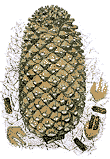 Cones and cone scales. [SOURCE UNKNOWN. PLEASE CONTACT ME IF YOU KNOW ARTIST OR WEBSITE OF ORIGIN.] | Encephalartos altensteinii LehmannCommon NamesBreadtree, broodboom; uJobane (Zulu) (1).Description"This is a tall species, the stems up to 22 feet (6.7 m) high ... The trees may be branched or unbranched. The leaves are exceptionally long, often up to 10 feet (about 3 m), and are straight or curved backwards. The leaflets are rigid and fairly broad, the middle ones up to just over 1 inch (2.5 cm) in width, with one or both margins toothed. ... Usually 2-5 cones are borne together. They are greenish-yellow, up to 22 inches (56 cm) long, the female scales covered with protruberances. The seeds are large, up to just over 1 1/2 inches (3.8 cm) in length, and scarlet."The species closely resembles E. natalensis but lacks the prickles at the base of the leaf stalk found in the latter" (1). RangeSouth Africa: "west bank of the Bushman's River in the south, northwards to the southern border of Natal, usually in coastal bush and forest" (1).Ethnobotany"It has been claimed that the seeds of this species are not toxic but this has not been proved scientifically. Africans in the East London district [of South Africa] believe them edible, and the authors of The Medicinal and Poisonous Plants of Southern and Eastern Africa say that the ripe seed has been eaten with impunity by the Zulu in times of famine. (Possibly in the latter case the species has been confused with E. natalensis). Children and birds have been seen eating the gum exuding from a cone" (1).ObservationsSaw at Sydney Botanical Garden.Remarks"The name altensteinii commemmorates a German chancellor of the 19th century."[T]his is a plant of exceptional vitality. Marloth noted that trunks which had lain in a shed for four years were perfectly capable of growing. When planted they produced new leaves in the next summer" (1). The species is threatened by illegal collecting, as shown by this news report: "[I]n 1995 ... a cycad smuggler [was arrested for] filling two tractor-trailers with Encephalartos altensteinii. The 40 tons of cycads were worth more than $1 million" (2). Citations(1) Palmer & Pitman 1972.(2) Maykuth, Andrew. 13-Apr-1998. Front Page: S. Africa is trying to protect its cycads, an endangered species from the dinosaur era. Philadelphia Inquirer. Accessed online 12-Jan-1999 at http://www.phillynews.com/inquirer/98/Apr/13/front_page/CYCA13.htm. See also Jones 1993. |
[Encephalartos] [Zamiaceae] [home] This page is from the Gymnosperm Database |